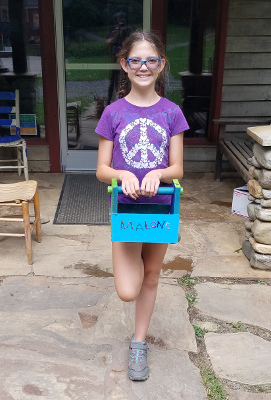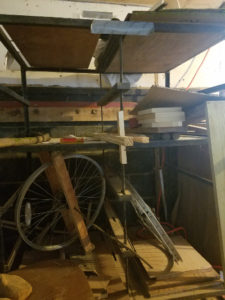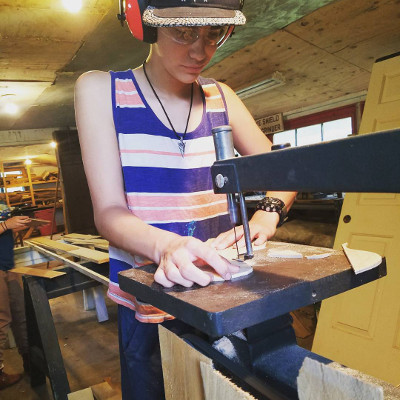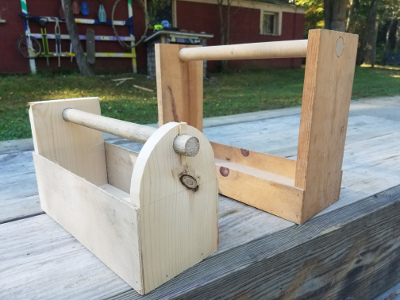How to Build Success in a Middle School Wood Shop

As anyone who has ever visited a middle school wood shop can attest, young adolescents are amazing at starting projects. At Arthur Morgan School, the current contents of project shelf include a half-finished jewelry box, five pieces of miscellaneous cut wood, a large, possibly abandoned sandbox, a small wall of glued-together dowels, and something that looks like a Ferris wheel stuck together with sticks and bicycle parts.
Wood Shop Woes
 This is just a small fraction of the student body’s output of half-finished projects that appear throughout the year. Before the school year started, I cleaned out half-shaped bows, derelict catapults, rough-cut spoons, planks with half burned messages, and various projects stuck to other projects with glue or paint. “Do not touch!!!” signs were on all of them. However, as those signs gathered dust, one tried not to touch, but one did wonder. Not wonder about their dexterity or drive—students at AMS all gain an understanding of tools and how to use them. They are never without projects and plans. It is the shifting nature of these projects and plans that fascinates me. When I am admiring their creativity, I call it a multiplicity of interests. When I am cleaning out the project shelf, I call it a lack of follow-through.
This is just a small fraction of the student body’s output of half-finished projects that appear throughout the year. Before the school year started, I cleaned out half-shaped bows, derelict catapults, rough-cut spoons, planks with half burned messages, and various projects stuck to other projects with glue or paint. “Do not touch!!!” signs were on all of them. However, as those signs gathered dust, one tried not to touch, but one did wonder. Not wonder about their dexterity or drive—students at AMS all gain an understanding of tools and how to use them. They are never without projects and plans. It is the shifting nature of these projects and plans that fascinates me. When I am admiring their creativity, I call it a multiplicity of interests. When I am cleaning out the project shelf, I call it a lack of follow-through.
Structured for Success
However, there are some success stories in the wood shop. AMS is just finishing its Settlers of AMS unit. During the last few weeks, students took classes in various craft spaces on campus: the pottery studio, the fiber arts space, the garden, and the wood shop. The purpose of this unit was to get students accustomed to these spaces and to the tools and techniques required to use them.
 In the wood shop, the students’ task was to plan and construct a pole-handled tool box. Along the way, they used a variety of tools and techniques. They cut their pieces with either a hand saw, scroll saw, or cross-cut saw; they joined the pieces with nails or screws; and they learned to use the cordless drill and drill press. Some students took it to the next level and shaped their handles with a draw horse and drawknife. With only two days in the shop, students planned and cut in their first class and assembled everything in the second.
In the wood shop, the students’ task was to plan and construct a pole-handled tool box. Along the way, they used a variety of tools and techniques. They cut their pieces with either a hand saw, scroll saw, or cross-cut saw; they joined the pieces with nails or screws; and they learned to use the cordless drill and drill press. Some students took it to the next level and shaped their handles with a draw horse and drawknife. With only two days in the shop, students planned and cut in their first class and assembled everything in the second.
Projects Completed
 Every student completed their project! Granted, some of the more ambitiously-shaped tool boxes stayed on the shelf for a week, but each one was finished! Scout, an eighth grader, made her tool box as a present for her mom. She painted and decorated it during her free time. Scout frequently has wood-related project ideas. She is the mastermind behind the sandbox and the wall of dowels. The toolbox, however, is the first one she has brought to completion. Her pride over the project is obvious as she shows it off to everyone she sees. Additionally, she also now has experience of translating her own power into functional and attractive wooden objects.
Every student completed their project! Granted, some of the more ambitiously-shaped tool boxes stayed on the shelf for a week, but each one was finished! Scout, an eighth grader, made her tool box as a present for her mom. She painted and decorated it during her free time. Scout frequently has wood-related project ideas. She is the mastermind behind the sandbox and the wall of dowels. The toolbox, however, is the first one she has brought to completion. Her pride over the project is obvious as she shows it off to everyone she sees. Additionally, she also now has experience of translating her own power into functional and attractive wooden objects.
I am not naive. I don’t think these completed tool boxes will suddenly solve the problem of the project shelf. And honestly, with the wealth of opportunities open to our students there is something to be said for an incomplete project. Starting projects is as much a skill as finishing them and now Scout, and the rest of the students, have the experience of completing one. They should be able to repeat that experience—in their imaginations, at least, if not in fact.
-By John Tanner Horst
